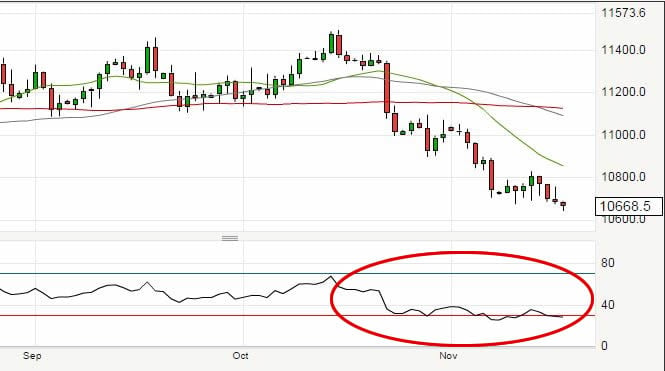The EUR/USD is Oversold, FOMC Sparks Correction
The EURUSD exchange rate has been under pressure for weeks now; we get the sense that the move is overextended and ask whether it can continue in the near term.

The euro to dollar exchange rate (EURUSD) has recovered some ground following the release of the minutes to the October FOMC meeting. The minutes showed that a December interest rate rise is not yet set in stone.
While a rate rise is off the table there was not enough to encourage yet more dollar-buying and profit taking will aid a now over-sold euro.
EURUSD does still however remain below the 1.08 resistance area and looks prone to further declines. At the time of writing the conversion is seen at 1.0675; the lowest point since April.
“Downward momentum remains strong and the current weakness could extend further to the next support near 1.0640,” says U.O.B analyst Quek Ser Leang from Singapore.
From a tactical perspective U.O.B have expressed reservations with chasing the exchange rate much lower and look to book profit nearer to 1.0600 noting that the present period of selling pressure may be overdone.
“While the bearish phase that started earlier this month is still intact, the current movement is quickly approaching oversold and the next major support at 1.0600 would not be easy to crack. In other words, those who are short may likely to book some profit near to 1.0600,” says Leang.
U.O.B’s stop-loss remains unchanged at 1.0840 even though 1.0770 is already a strong short-term resistance.
This is Why the Euro is Oversold?
Are you concerned that markets are getting ahead of themselves when it comes to selling the EUR? The problem with moves that become over-extended is that any rebounds tend to be quite sharp and can hurt those in the market who were not expecting them.
Typically we are able to gauge whether a move is over-extended by observing the Relative Strength Index (RSI) on the exchange rate’s charts.
As we can see on the EURUSD’s daily chart, the RSI is below the 30 level:

A reading at or below 30 is considered oversold while a reading at or above 70 is considered overbought.
The thinking goes that the RSI must revert back to its longer-term average around 50 which is seen as representing equilibrium.
“RSI has trended strongly lower and now remains firmly entrenched within oversold territory. Subsequently, expect to see a small retracement to relieve the pressure on the indicator, prior to further bearish falls,” says Steven Knight, Research Analyst for Blackwell Global.
However, as the above graphic shows, the euro / dollar exchange rate has been at oversold levels for much of November which confirms the RSI is not giving us much indicative powers when attempting to call a rebound.
Nevertheless, what it does tell us is that the downside move is exhausted and it will take major fundamental news events to convince the markets that the euro can be chased lower in the near-term.
There are also indications that there are not enough buyers left to chase the euro lower.
Reuters report that billions in currency options are set between $1.04 and $1.07 – the structure of the market is therefore not friendly to further major US dollar advances at this stage.
Data from U.S. securities clearing house DTCC, shows some $12 billion in options with strike prices around $1.05, $1.06 and $1.07 maturing on Dec. 18.
"A lot of people have been putting on downside option structures and the market has been aware of them for a while," said an institutional dealer in London quoted by Reuters.
"That is one of the big reasons why you are seeing a lot of stickiness around these levels and it may be hard to push through."
The CitiFX Flows team say their 20-day aggregate USD flow data from leveraged accounts has reached its highest level since the start of flow data series in January 2012.
"The silver lining though for EUR from a short-term positioning perspective is that hedge funds appear to be stretched in long USD / short EUR trades," says a note from Citibank on the matter.
Nevertheless, remember that the fundamental picture remains one that is dollar supportive and euro negative.
"We note that the importance of potential divergence between rates in the US if the Fed begins a rate hike cycle and the euro area if the ECB eases again in December cannot be overstated,” say Credit Suisse.
Credit Suisse are part of a cohort of major institutions forecasting the euro to dollar exchange rate to reach parity in 2016.
The move lower is therefore a longer-term game, patience is required.










